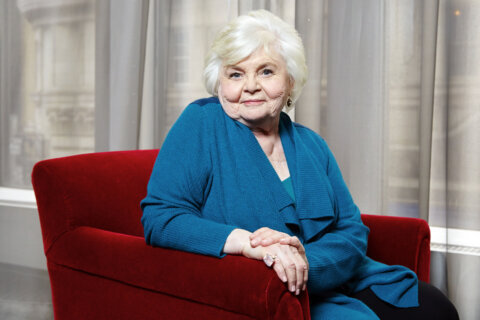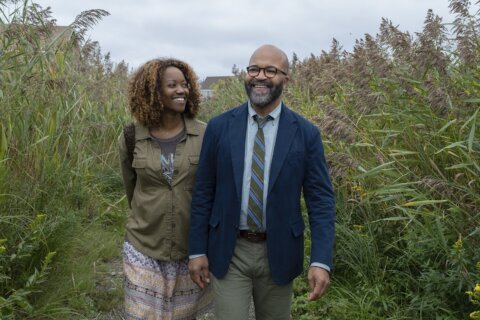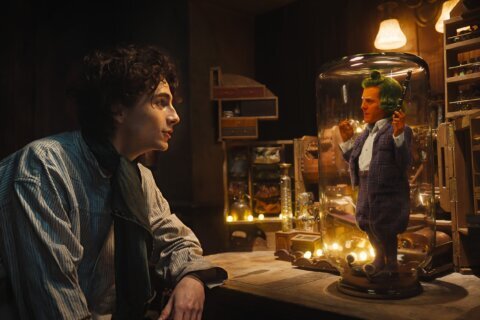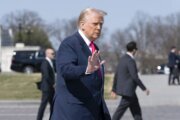WASHINGTON — How much freedom would you give up for security?
It sounds like a political debate over NSA spying and drone warfare, but it’s also the subject of “Captain America: The Winter Soldier,” the ninth installment of the Marvel Cinematic Universe.
It’s Mr. Rogers Goes to Washington, not the shoe-tossing children’s host, but the shield-tossing children’s hero, Steve Rogers (Chris Evans), who rose from pipsqueak to chiseled World War II hero in “Captain America: The First Avenger” (2011), before being cryogenically frozen for decades and then thawed to team up with his super friends — Iron Man, Thor and The Incredible Hulk — to save New York City in “The Avengers” (2012).
See my video review below:
“Winter Soldier” begins shortly after the events of New York, as Captain America sprints around the National Mall, Tidal Basin and Reflecting Pool, hilariously passing joggers by warning “on your left.” He even has his own exhibit at the Air & Space Museum, a clever way to remind viewers of elements from the last film without relying on dialogue exposition. Here’s to creative solutions to common problems!
Washingtonians will be most stoked to see that Nick Fury (Samuel L. Jackson) has built his entire S.H.I.E.L.D. headquarters in Rosslyn, Va., with underground bunkers hiding secret military aircraft and glass elevators showing the Watergate Hotel and Kennedy Center ever present in the background.
In this way, the film pulls off the difficult task of blending two very different genres — the comic-book action fantasy and the political thriller, the latter gaining its cred from Robert Redford as defense secretary Alexander Pierce. Redford’s performance recalls his great ’70s political thrillers such as “Three Days of the Condor” (1975) and “All the President’s Men” (1976), the latter of which is referenced as a character blares a record player while texting Rogers, “Ears everywhere.”
Those Redford films run circles around “Winter Soldier” — just like Cap passing those joggers on the Mall — but Marvel deserves major credit for having the guts to play in this lane. The directing duo of brothers Anthony and Joe Russo take a “Bourne” approach to the action, using hand-to-hand combat more than CGI explosions (although there are plenty of those in the film’s overblown finale — a recurring problem for Marvel). The best martial arts- style scene comes when Cap decimates a dozen henchmen in an elevator, then stomps his shield back up into his hand.
Still, the Russos’ biggest strength is comedy, hailing from TV’s “Community” and “Arrested Development.” Their humor shines through as Captain America echoes “Captain Phillips” and destroys a ship of pirates, landing punches with comedic timing. They also take a page from Joss Whedon with countless pop culture references, stemming from Cap’s “to do list” from his cryogenically frozen years (i.e. “I Love Lucy”). Natasha Romanoff, a.k.a The Black Widow (Scarlett Johansson), cracks a joke that doubles as “WarGames” (1983) and “Saw” (2004), while Sam Wilson, a.k.a. The Falcon (Anthony Mackie), says Marvin Gaye’s “Trouble Man” will explain the 20th century.
But this is no longer the 20th century. This is the 21st century, where post-Sept. 11 fears run rampant. While we thought Cap had defeated the Nazi offshoot HYDRA last time around, the group has been secretly stoking fear across the globe, waiting for mankind to willingly give up its freedom in the name of security, so that it can consolidate power from inside the World Security Council.
The enforcer of this new world order is a Soviet-trained super villain, the Winter Soldier, which was also the name of a great 1972 Vietnam documentary. This silent assassin is mysterious, but not nearly as developed as the last villain, Red Skull (Hugo Weaving), or his brainiac sidekick, Dr. Arnim Zola (Toby Jones). Here the evil is on a much grander, more ideological scale.
Jackson’s Nick Fury and Redford’s defense secretary respond to this new-millennium threat in similar ways, Fury saying, “S.H.I.E.L.D. takes the world as it is, not as we’d like to be,” and Redford saying, “You know how the game works: disorder, war — all it takes is one step.” Captain America pushes back against both, telling Redford, “I thought the punishment usually came after the crime,” and telling Jackson, “You hold a gun on everyone on Earth and call it protection. This isn’t freedom. This is fear.”
Such themes make the film a more relevant social commentary than much of the series. At the same time, these themes articulate the ongoing curse of an endless franchise.
Marvel has become HYDRA, as fans sacrifice the freedom of new ideas for the security of formula.
In this formula, characters always live to fight another day, diluting any feeling of real dread. Screenwriters Christopher Markus and Stephen McFeely (“Thor: The Dark World”) appear to offer us pivotal moments, then undo that which would have made the film truly memorable. Vito Corleone was allowed one death reversal in “The Godfather” (1972) after getting shot at the fruit stand, but if he came back again after dropping dead in the garden, and then Sonny came back to life as Michael’s assassin in “Part II” (1974), Coppola would have lost all credibility. Of course, these are vastly different genres, but you can only tinker with logic so much. Nick Fury’s motto may be “don’t trust anyone,” but when you twist too much, it’s the writers who lose our trust.
Perhaps more problematic, there is never any closure in the Marvel Cinematic Universe, because the next teaser awaits just after the end credits. And you better have seen all nine films, baby, or you’ll wonder why other audience members are “oohing” and “ahhing” over Scepters and Tesseracts. This is a roller coaster you can’t board mid-ride or you’ll be tossed off, while fanboys and fangirls raise their hands for the coaster’s next drop, craving that popcorn tingle in the belly.
I loved the thrill of this “Captain America.” It was indeed a great ride. But how many times can we go around this Marvel track before we all get sick? Better yet, what other great rides are we missing?
If this were “Captain American Idol,” we’d be on Season 9, exactly when Simon Cowell leaves the show. And just like “Idol,” we’ll only remember the first handful in hindsight. Tony Stark was a Kelly Clarkson hit; Bruce Banner was Clay Aiken hulking up into Ruben Studdard; “Iron Man 2” flopped by choosing Fantasia over Jennifer Hudson; Thor boomed with a Carrie Underwood voice from the gods; and Taylor Hicks was a throwback like Captain America. Occasionally, an Idol reunion will work (i.e. “The Avengers”), but how many winners can you name past the first six seasons? My point exactly.
When the best lists are written, history will forget Marvel Phase Two. But Marvel isn’t playing for history. It’s playing for fun and it’s playing for money. It’s very good at both. And so we rage on toward “Avengers 2,” buying our golden tickets, willingly giving up our film freedom for the manufactured security of the familiar, texting our votes to Nick “Seacrest” Fury with the collective cheer:
“We’re going to Hollywood!”
★ ★ ★
The above rating is based on a 4-star scale. See where this film ranks in Jason’s 2013 Movie Guide. Follow WTOP Film Critic Jason Fraley on Twitter @JFrayWTOP, read his blog The Film Spectrum or listen Friday mornings on 103.5 FM.








